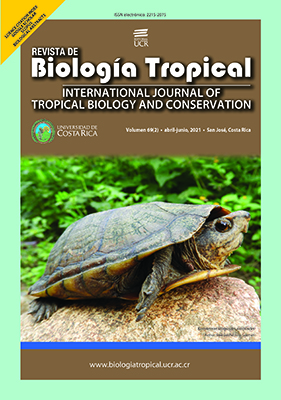Abstract
Introduction: Anadara tuberculosa is an economically important fishery resource of mangrove ecosystems in the tropical Eastern Pacific. Objective: The objective of this study was to analyze the size structure, distribution, and density of A. tuberculosa, in the Gulf of Montijo (GM) and Mangroves of David (MD) in the Panamanian Pacific, to assess the state of the resource in Panama's two Pacific mangrove systems. Methods: We analyzed Gulf of Montijo historical clam size records and densities from 2004 and 2020. Hundred and seven 30 m2 permanent plots (51 from GOM and 56 from MOD) were set and sampled in 2016 at four time intervals (dry season, transition into rainy, rainy season and transition into dry season) to obtain clams sizes, densities and distributions. The plots were sampled again in 2019. Physical variables such as temperature (°C), salinity (PSU) and pH from the water retained in the mangrove channels were also recorded. Nine transects were installed and sampled in 2019. Three at the seaward edge of the mangrove fringe, three at the inshore edge, and three half-way between the first two. Three quadrats were sampled at the beginning, middle and end of each transect. Results: Gulf of Montijo A. tuberculosa were found to larger but at lower densities than those from Mangroves of David. At each site, size comparison by sampling period, were statistically significant only for GOM, where larger sizes were found in March and July and smaller sizes in October-December. There was no correlation between the distributions of A. tuberculosa and temperature, salinity and pH. A sustained decrease in A. tuberculosa densities was found for GOM (1.82 ind/m2 in 2004 to 0.6 ind/m2 in 2019). This contrast with the predominantly larger clam sizes above 50 mm in total length and an increase in mean size of collected individuals (52.62 mm in 2004 to 59.28 mm in 2020). Specimens of A. tuberculosa were found up to slightly more than 2 km inshore from the main channel and within slightly more than 500 m from a secondary channel. Clam densities decreased and sizes increased in a seaward-inshore direction. Conclusions: For A. tuberculosa, the combination of size classes larger than 50 mm and low densities of individuals is evidence of population deterioration associated to fishery and environmental stressors.
##plugins.facebook.comentarios##

This work is licensed under a Creative Commons Attribution 4.0 International License.
Copyright (c) 2021 Ángel Javier Vega, Yolani A. Robles P., Onelys Alvarado, Carlos Cedeño Mitre







